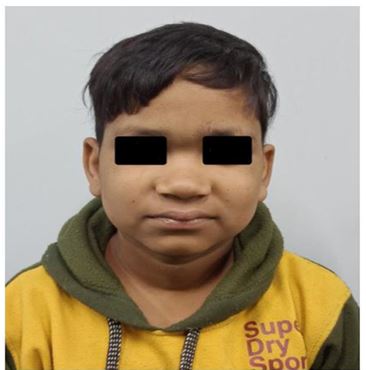Clinical Image - Volume 3 - Issue 4
Uncommon clinical features of juvenile primary hypothyroidism
Md Ejaz Alam1*; Muqeem Farooq2; Abid Bhat1*; Mohammad Hayat Bhat3
1Senior Resident, Department of Endocrinology, SSH, GMC, Srinagar, India.
2Junior Resident, Department of Endocrinology, SSH, GMC, Srinagar, India.
3Assistant Professor, Department of Endocrinology, SSH, GMC, Srinagar, India.
Received Date : May 17, 2023
Accepted Date : June 29, 2023
Published Date: July 06, 2023
Copyright:© Md. Ejaz Alam 2023
*Corresponding Author : Md. Ejaz Alam, Senior Resident, Department of Endocrinology, SSH, GMC, Srinagar, India.
Email: ejazpmch@gmail.com
DOI: Doi.org/10.55920/2771-019X/1481
Abstract
This case study presents an 18-year-old boy with severe short stature and distinct physical features, including facial abnormalities, skeletal deformities, and intellectual impairment. Further investigations revealed hypothyroidism, autoimmune thyroiditis, and delayed bone age. Treatment with levothyroxine replacement therapy was initiated. The study highlights the importance of detection and management of hypothyroidism in individuals with short stature and associated features.
Keywords : Short stature; Hypothyroidism; Intellectual function; Autoimmune thyroiditis.
Case Summary
An 18-year-old boy, the result of a non-consanguineous marriage, was brought to the endocrinology clinic by his parents due to concerns about his short stature, which had been noticeable for the past 8 years. The patient did not have a history of headaches, visual difficulties, hearing impairments, joint pain, chronic cough, altered bowel habits, bone pain, or fractures. There were no reported cases of short stature, psychiatric disorders, or behavioural abnormalities in the family. Upon examination, the patient appeared pale. His height was measured at 128.5 cm, which was below the 3rd percentile. The standard deviation score (SDS) was calculated to be -6.8. Mid-parental height (MPH) was estimated at 155.5 cm, and the target height was 158 cm. The upper segment/lower segment ratio was 1.03. The patient had delayed knee and ankle reflexes. His sexual maturity rating (SMR) was SPL 8.6 CM, A1 for the axillary hair stage and P1 for the pubic hair. Testicular size was enlarged, measuring 20 ml bilaterally. The patient displayed distinct facial features, including a round and puffy face, a flat bridge of the nose, dry and coarse skin, low-set ears, a short neck, grade 3 acanthosis nigricans (skin discoloration), short and stubby fingers (Panel A), and bowed legs. X-ray of the hand showed delayed bone age (11 years) with Madelung deformity (Panel B), x-ray of the dorsolumbar spine showed bullet-shaped vertebrae and central beaking of vertebrae (Panel C), and an x-ray of the skull revealed an enlarged sella (white arrow) and Wormian bones (black arrow) (Panel D). Thyroid ultrasound revealed eutopic with heterogeneous echotexture (Panel E). The patient tested positive for anti-thyroid peroxidase antibodies (Anti-TPO) at a level exceeding 1000 IU/ml, with a thyroid-stimulating hormone (TSH) level of 433 mIU/L. An IQ test revealed a borderline level of intellectual function. During hospitalisation, the patient was treated with levothyroxine replacement therapy and received iron and folic acid supplementation.

Figure 1: X-ray of the hand showed stubby fingers (Panel A), delayed bone age (11 years) with Madelung deformity (Panel B), x-ray of the dorsolumbar spine showed bullet-shaped vertebrae and central beaking of vertebrae (Panel C), and an x-ray of the skull revealed an enlarged sella (white arrow) and Wormian bones (black arrow) (Panel D). Thyroid ultrasound revealed a heterogeneous echotexture (Panel E).

Figure 2: 18 year old boy with distinct facial features, round and puffy face, increased inner canthal distance (3 cm), flat bridge of the nose, low-set ears, and short neck.

